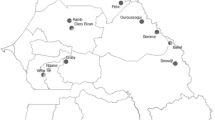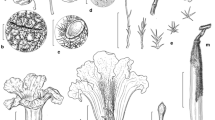Abstract
132 cultivated populations (2x–16x) of 15 arctic-alpine species ofDraba were investigated to clarify a possible relationship between reproductive strategies and polyploid evolution in the genus. The populations were exclusively sexual and produced viable seed after spontaneous self-pollination, but showed large variation both in traits promoting cross-pollination and in autogamous fruit and seed set. Traits promoting cross-pollination, e.g., floral display, protogyny, and delayed selfing, were positively correlated, and these traits were negatively correlated with autogamous fruit and seed set. All diploid and many polyploid populations had high autogamous seed set and small, unscented, non-protogynous, and rapidly selfing flowers. In contrast, all populations with low autogamous seed set and large, scented, and strongly protogynous flowers with distinctly delayed selfing were polyploid. These results are consistent with those previously obtained from enzyme electrophoresis, suggesting that the genetically depauperate diploids are extreme inbreeders and that the highly fixed-heterozygous polyploids vary from extreme inbreeders to mixed maters. The reproductive data lend additional support to the hypothesis that allopolyploidy in arcticDraba serves as an escape from genetic depauperation caused by uniparental inbreeding at the diploid level.
Similar content being viewed by others
References
Aizen, M. A., Searcy, K. B., Mulcahy, D. L., 1990: Among- and within-flower comparisons of pollen tube growth following self-and cross-pollinations inDianthus chinensis (Caryophyllaceae). — Amer. J. Bot.77: 671–676.
Al-Shehbaz, I. A., 1977: Protogyny in theCruciferae. — Syst. Bot.2: 327–333.
—, 1987: The genera ofAlysseae (Cruciferae; Brassicaceae) in the southeastern United States. — J. Arnold Arbor.68: 185–240.
Arroyo, M. T. K., Squeo, F., 1990: Relationship between plant breeding systems and pollination. — InKawano, S., (Ed.): Biological approaches and evolutionary trends in plants, pp. 205–227. — London: Academic Press.
Asker, S., 1984: Apomixis and biosystematics. — InGrant, W. F., (Ed.): Plant biosystematics, pp. 237–248. — Toronto: Academic Press.
Baker, J. D., Cruden, R. W., 1991: Thrips-mediated self-pollination of two facultatively xenogamous wetland species. — Amer. J. Bot.78: 959–963.
Barrett, S. C. H., Eckert, C. G., 1990: Variation and evolution of mating systems in seed plants. — InKawano, S., (Ed.): Biological approaches and evolutionary trends in plants, pp. 229–254. — London: Academic Press.
—,Shore, J. S., 1989: Isozyme variation in colonizing plants. — InSoltis, D. E., Soltis, P. S., (Eds): Isozymes in plant biology, pp. 106–126. — Portland: Dioscorides Press.
Bell, K. L., Bliss, L. C., 1980: Plant reproduction in a high arctic environment. — Arctic Alpine Res.12: 1–10.
Bierzychudek, P., 1985: Patterns in plant parthenogenesis. — Experientia41: 1255–1264.
—, 1987: Patterns in plant parthenogenesis. — InStearns, S. C., (Ed.): The evolution of sex and its consequences, pp. 197–217. — Basel: Birkhäuser.
—, 1989: Environmental sensitivity of sexual and apomicticAntennaria: do apomicts have general-purpose genotypes? — Evolution43: 1456–1466.
—, 1990: The demographic consequences of sexuality and apomixis inAntennaria. — InKawano, S., (Ed.): Biological approaches and evolutionary trends in plants, pp. 293–307. — London: Academic Press.
Bliss, L. C., 1971: Arctic and alpine plant life cycles. — Ann. Rev. Ecol. Syst.2: 405–438.
Böcher, T. W., 1966: Experimental and cytological studies on plant species. IX. Some arctic and montane crucifers. — Biol. Skr.14: 1–74.
Bolkhovskikh, Z., Grif, V., Matvejeva, T., Zakharyeva, O., 1969: Chromosome numbers of flowering plants. — Leningrad: Nauka.
Bretten, S., 1990:Draba oxycarpa Sommerf. — InGjærevoll, O., (Ed.): Maps of distribution of Norwegian vascular plants.2. Alpine plants, p. 61. — Trondheim: Tapir Publ.
Brochmann, C., 1992: Pollen and seed morphology of NordicDraba (Brassicaceae): phylogenetic and ecological implications. — Nordic J. Bot.12: 657–673.
-Elven, R., 1992: Ecological and genetic consequences of polyploidy in arcticDraba (Brassicaceae). — Evol. Trends Pl.6 (in press).
—,Borgen, L., Stedje, B., 1989a: Chromosome numbers and crossing experiments in Nordic populations ofDraba (Brassicaceae). — In: 4th International Symposium of Plant Biosystematics: biological approaches and evolutionary trends in plants. Abstract, p. 39. — Kyoto: Kyoto University.
- - - 1993: Crossing relationships and chromosome numbers of Nordic populations ofDraba (Brassicaceae), with emphasis on theD. alpina complex. — Nordic J. Bot. (in press).
—,Soltis, D. E., Soltis, P. S., 1992a: Electrophoretic relationships and phylogeny of Nordic polyploids inDraba (Brassicaceae). — Pl. Syst. Evol.182: 35–72.
—,Soltis, P. S., Soltis, D. E., 1989b: Evolutionary trends in Nordic populations ofDraba (Brassicaceae). — In: 4th International Symposium of Plant Biosystematics: biological approaches and evolutionary trends in plants. Abstract, p. 39. — Kyoto: Kyoto University.
—, —, —, 1992b: Multiple origins of the octoploid Scandinavian endemicDraba cacuminum: electrophoretic and morphological evidence. — Nordic J. Bot.12: 257–272.
—, —, —, 1992c: Recurrent formation and polyphyly of Nordic polyploids inDraba (Brassicaceae). — Amer. J. Bot.79: 673–688.
-Stedje, B., Borgen, L., 1992d: Gene flow across ploidal levels inDraba (Brassicaceae). — Evol. Trends Pl.6 (in press).
Charlesworth, D., Charlesworth, B., 1987: Inbreeding depression and its evolutionary consequences. — Ann. Rev. Ecol. Syst.18: 237–268.
Cruden, R. W., 1977: Pollen-ovule ratios: a conservative indicator of breeding systems in flowering plants. — Evolution31: 32–46.
Ehrendorfer, F., 1980: Polyploidy and distribution. — InLewis, W. H., (Ed.): Polyploidy. Biological relevance, pp. 45–60. — New York: Plenum Press.
Ekman, E., 1917: Zur Kenntnis der nordischen Hochgebirgs-Drabae. — Kungl. Sv. Vetensk. Handl.57: 1–68.
Grant, V., 1981: Plant speciation. 2nd edn. — New York: Columbia University Press.
Gustafsson, Å, 1946: Apomixis in higher plants. Part I. The mechanism of apomixis. — Lunds Universitets Årsskrift N. F. Avd. 2,42(3: 1–67.
—, 1947a: Apomixis in higher plants. Part II. The causal aspects of apomixis. — Lunds Universitets Årsskrift N. F. Avd. 2,43(2: 69–179.
—, 1947b: Apomixis in higher plants. Part III. Biotype and species formation. — Lunds Universitets Årsskrift N. F. Avd. 2,43(12: 181–370.
Heyn, C. C., Snir, S., 1986: Selfing and pollen allocation in someAsteraceae. — Proc. Royal Soc. Edinburgh89 B: 181–192.
Håpnes, A., 1991a: Populasjonsbiologiske studier avDraba alpina ogD. oxycarpa på Knutshø i Oppdal kommune, Sør-Trøndelag. — Univ. Trondheim Vitensk. Mus. Rapp. Bot. Ser.1991(2: 43–57.
- 1991b: Reproduksjonsbiologi og demografi i relasjon til økologi hjåDraba alpina ogD. oxycarpa på Knutshøene, Oppdal. — Cand. scient. thesis, University of Oslo.
Kay, Q. O. N., Harrison, J., 1970: Biological flora of the British Isles.Draba aizoides L. — J. Ecology58: 877–888.
Kevan, P. G., 1972a: Floral colors in the high arctic with reference to insect-flower relations and pollination. — Canad. J. Bot.50: 2289–2316.
—, 1972b: Insect pollination of high arctic flowers. — J. Ecol.60: 831–847.
Knaben, G., 1966: Cytotaxonomical studies in someDraba species. — Bot. Not.119: 427–444.
Kozlowski, J., Stearns, S. C., 1989: Hypotheses for the production of excess zygotes: models of bet-hedging and selective abortion. — Evolution43: 1369–1377.
Lande, R., Schemske, D. W., 1985: The evolution of self-fertilization and inbreeding depression in plants. I. Genetic models. — Evolution39: 24–40.
Lloyd, D. G., 1980: Demographic factors and mating patterns in angiosperms. — InSolbrig, O. T., (Ed.): Demography and evolution in plant populations, pp. 67–88. — Oxford: Blackwell Scientific Publications.
Löve, A., Löve, D., 1975: Cytotaxonomical atlas of the Arctic flora. — Vaduz: Cramer.
Masuyama, S., Watano, Y., 1990: Trends for inbreeding in polyploid pteridophytes. — Pl. Spec. Biol.5: 13–17.
Mosquin, T., 1966: Reproductive specialization as a factor in the evolution of the Canadian flora. — InTaylor, R. L., Ludwig, R. A., (Eds): The evolution of Canada's flora, pp. 43–65. — Toronto: Toronto University Press.
—,Martin, J. E. H., 1967: Observations on the pollination biology of plants on Melville Island, N. W. T., Canada. — Canad. Field Naturalist8: 201–205.
Mulligan, G. A., 1971: Cytotaxonomic studies ofDraba species of Canada and Alaska:D. ventosa, D. ruaxes, andD. paysonii. — Canad. J. Bot.49: 1455–1460.
—, 1972: Cytotaxonomic studies ofDraba species in Canada and Alaska:D. oligosperma andD. incerta. — Canad. J. Bot.50: 1763–1766.
—, 1974: Confusion in the names of threeDraba species of the arctic:D. adamsii, D. oblongata, andD. corymbosa. — Canad. J. Bot.52: 791–793.
—, 1976: The genusDraba in Canada and Alaska: key and summary. — Canad. J. Bot.54: 1386–1393.
—,Findlay, J. N., 1970: Sexual reproduction and agamospermy in the genusDraba. — Canad. J. Bot.48: 269–270.
Murray, D. F., 1987: Breeding systems in the vascular flora of Arctic North America. — InUrbanska, K. M., (Ed.): Differentiation patterns in higher plants, pp. 239–262. — London: Academic Press.
Norusis, M. J., 1986: SPSS/PC+. Advanced statistics. — Chicago: SPSS Inc.
Philipp, M., Böcher, J., Mattsson, O., Woodell, S. R. J., 1990: A quantitative approach to the sexual reproductive biology and population structure in some arctic flowering plants:Dryas integrifolia, Silene acaulis, andRanunculus nivalis. — Meddelelser om Grønland, Biosci.34: 1–60.
Preston, R. E., 1986: Pollen-ovule ratios in theCruciferae. — Amer. J. Bot.73: 1732–1740.
Price, R. A., 1980:Draba streptobrachia (Brassicaceae), a new species from Colorado. — Brittonia32: 160–169.
Radford, A. E., Dickison, W. C., Massey, J. R., Bell, C. R., 1974: Vascular plant systematics. — New York: Harper & Row.
Richards, A. J., 1986: Plant breeding systems. — London: George Allen & Unwin.
Rønning, O. I., 1979: Svalbards flora. 2nd edn. — Oslo: Norsk Polarinstitutt.
Schulz, O. E., 1927:Cruciferae—Draba etErophila. — InEngler, A., Prantl, K., (Eds): Das Pflanzenreich4(105): 1–396. — Leipzig: Engelmann.
Schütz, M., 1988: Genetisch-ökologische Untersuchungen an alpinen Pflanzenarten auf verschiedenen Gesteinsunterlagen: Keimungs- und Aussaatversuche. — Veröff. Geobot. Inst. ETH, Stiftung Rübel, Zürich99: 1–153.
Seidenfaden, G., Sørensen, T., 1937: The vascular plants of Northeast Greenland from 74°30′ to 79°00′ N. lat. and a summary of all species found in East Greenland. — Meddelelser om Grønland101: 1–215.
Soltis, D. E., Soltis, P. S., 1992: The distribution of selfing rates in homosporous ferns. — Amer. J. Bot.79: 97–100.
Stebbins, G. L., 1950: Variation and evolution in plants. — New York: Columbia University Press.
—, 1971: Chromosomal evolution in higher plants. — London: Edward Arnold.
Tikhmenev, E. A., 1984: Pollination and self-pollinating potential of entomophilic plants in arctic and mountain tundras of the northeastern USSR. — Soviet J. Ecol.15: 166–172. (1985): Translation from the Russian original; Ekologiya4: 8–15).
Vasek, F. C., Weng, V., 1988: Breeding systems ofClarkia sect.Phaeostoma (Onagraceae): I. Pollen-ovule ratios. — Syst. Bot.13: 336–350.
Dewet, J. M. J., 1980: Origins of polyploids. — InLewis, W. H., (Ed.): Polyploidy. Biological relevance, pp. 3–15. — New York: Plenum Press.
Author information
Authors and Affiliations
Rights and permissions
About this article
Cite this article
Brochmann, C. Reproductive strategies of diploid and polyploid populations of arcticDraba (Brassicaceae). Pl Syst Evol 185, 55–83 (1993). https://doi.org/10.1007/BF00937720
Received:
Accepted:
Issue Date:
DOI: https://doi.org/10.1007/BF00937720




